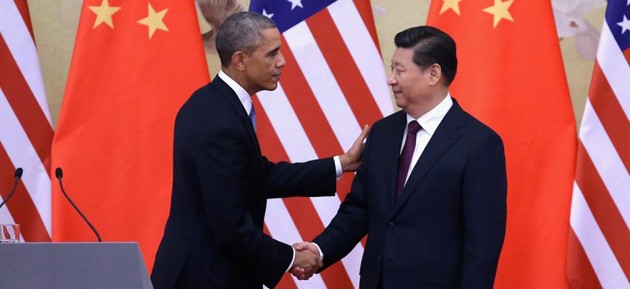
Barak Obama and Xi Jinping signed a landmark deal a couple of weeks ago committing both the United States and China to a roadmap which will, according to the University of Chicago’s Raymond Pierrehumbert, keep the world on the safe side of 1,000 gigotons of cumulative carbon in the atmosphere and thus below a 2 degree increase in average temperature.
While the science is complex and the politics even more so, the good news is that the two largest emitters who failed to sign the Kyoto agreement are, at least, talking about the issues involved and making commitments to deal with the problem.
Political issues
In the United States, President Obama has already run afoul of very powerful interests in supporting cleaner natural gas against coal and as discussed in a post concerning a speech Obama made in West point back in June, this president is actually doing something about the issue!
The new Republican majority in the U.S. congress and Senate will do its best to roll back some of the gains that have been made but my guess (or hope) is the presidential election of 2016 will bring back a democratic majority and keep the United States on the current path to hold emissions to 2005 levels or lower.
The criticism of the deal in the U.S. is that China does not have to begin lowering carbon emissions until 2030 but the fact is that even peaking in 2030 will require a huge effort for China to effectively plan its transition to a low carbon economy. The issue at the core of the most serious discussion is whether the Chinese can be trusted to actually live up to the deal.

In China, Slates’s Joshua Keating makes the point, with which I agree, that China agreed to the deal because it has to add more renewable and cleaner energy to its mix in order to limit air pollution. Any government, even a dictatorship, only governs with the consent of its people and as the Chinese people become more affluent, they like others before them will demand clean air, water and safe food.
Who gets to grow?

The other big issue is that economic growth requires energy and energy, at least conventionally, produces carbon. As explained in very clear terms by India’s Sunita Narain, the essence of the US – China deal is to get both countries on the same per capita carbon output at her estimate of 12-14 tons per person per year based on the U.S. reducing and China growing.
Ms. Narain’s point is that if both the U.S. and China produce carbon at that level, then the rest of the world will have to be much, much lower and countries like India will simply not be able to grow economically using conventional technology. In many ways her article in the Business Standard is a response to an article by Gardiner Harris in the New York Times that talks about the current coal boom in India and appears to argue for India to take a more expensive renewable path for its economic development.
The bigger issue is if the world will, in fact, get together on a comprehensive climate deal in the next few years and is the agreement between the US and China is a good first step in this process or, in a fact a side deal, between the two largest carbon emitters to make their own situation a fait accompli for the rest of the world to swallow.


“… energy, at least conventionally, produces carbon …” The problem is, taken all-in-all, even “renewables” with the exception of hydroelectric generation on balance produce CO2. Not only in the production cycle e.g. for wind turbines or photovoltaic panels and their later decommissioning, but equally when they run – as stand-by fossil-powered plants need to work at below capacity to fill in the “troughs” in energy production. Per Megawatt produced, this sub-optimal scheme then produces about as much, if not more, than if the missing MWs had been generated at fossil full capacity. So that, with whatever currently available energy source with a few exception currently out of favor (and rightly so too), there is no CO2-avoiding energy consumption growth path unless we want to lie to ourselves.
i think obama is doing moves to solidify his legacy